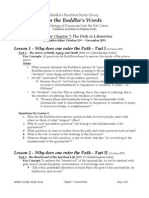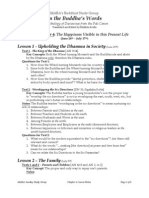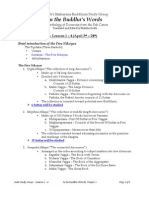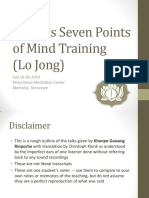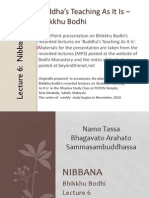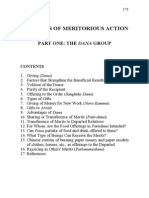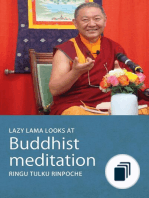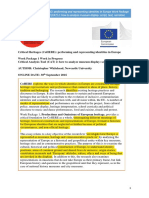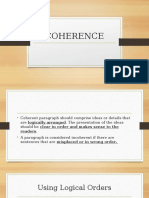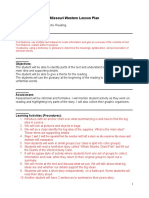In The Buddha's Words - Course Notes Chapter 6
In The Buddha's Words - Course Notes Chapter 6
Uploaded by
Kongmu ShiCopyright:
Available Formats
In The Buddha's Words - Course Notes Chapter 6
In The Buddha's Words - Course Notes Chapter 6
Uploaded by
Kongmu ShiOriginal Description:
Original Title
Copyright
Available Formats
Share this document
Did you find this document useful?
Is this content inappropriate?
Copyright:
Available Formats
In The Buddha's Words - Course Notes Chapter 6
In The Buddha's Words - Course Notes Chapter 6
Uploaded by
Kongmu ShiCopyright:
Available Formats
In the Buddhas Words
An Anthology of Discourses from the Pali Canon
Translated and Edited by Bhikkhu Bodhi
MABAs Buddhist Study Group
Notes for Chapter 6: Deepening Ones Perspective on the World
(Tentative dates: September 4th October 9th)
Lesson 1 Gratification, Danger, and Escape Part I (September 4
Text 1 Four Wonderful Things [AN 4:128] Key Concepts: Four wonderful and marvelous things appear with the manifestation of the Tathagata: People, subject to attachment, wish to listen to and understand the Buddhas teaching on non-attachment; People, subject to conceit, wish to listen to and understand his teaching for the abolition of conceit; People, subject to restlessness, wish to listen to and understand his teaching on peace; and People, subject to ignorance, wish to listen to and understand his teaching on for the abolition of ignorance. Texts 2 - 4 Gratification, Danger and Escape [AN 3:101 and AN 3:102] Key Concepts: Text 1 So long as the Buddha did not know fully the gratification, danger, escape from the world, he did not claim to have awakened to enlightenment. Text 2 The Buddha sought for and found how far gratification, danger, and escape extend in the world. Text 3 There truly is gratification, danger and escape in this world. Questions for Lesson 1: 1. Why are the four things mentioned in the first text wonderful? 2. Can you explain how gratification, danger, and escape relate to the Four Noble Truths? 3. Is it important to see all three moments (gratification, etc.) at the same time? How can we do this? 4. Is there a particular factor of the eightfold path that is most helpful in properly seeing gratification, danger, and escape? If so, which one? 5. What if we dont want to see the danger or the escape?
th)
Lesson 2 Gratification, Danger, and Escape Part II (Sept. 11
Text 1 Properly Appraising the Objects of Attachment [MN 13]
th)
MABA Sunday Study Group
Chapter 6 Course Notes
Page 1 of 5
Key Concept: Fully understand as it really is gratification as gratification, danger as danger, and escape as escape in regard to sensual pleasures, form, and feeling. Notes: The Buddha shows what gratification, danger, and escape entail for sense pleasures, form, and feeling: Gratification Indulging in sense objects pleasing to the senses. Enjoying the beauty of form. The bliss and rapture of feelings dependent upon attaining the jhanas. Danger Impermanent nature of sense objects, and how things dont work out the way we want them to. The aging and decay of beauty and form. The impermanent, and thereby unsatisfactory nature of any kind of feeling. Escape (the character used in the Chinese version is ch which literally means to come/go out; to exit, like to come out of a house) The removal of desire and lust, the abandonment of desire and lust for sense pleasures, form, and feeling. Questions for Lesson 2: 1. What does escape mean? What are we escaping from? 2. Can you give examples of how you have known these three moments in your life? 3. Absent complete and perfect enlightenment, what can we do now to engender a more realistic approach to the experience of sensual pleasures, form, and feelings?
Lesson 3 The Pitfalls in Sensual Pleasures (September 18
th)
Texts 1 Cutting Off all Affairs [from MN 54] Key Concept: The Buddha uses seven strong similes to describe how a noble disciple should view sensual pleasures, and thus cuts off all affairs. Notes: The seven similes are: Sensual pleasures are like: A meatless bone for a starving dog; A piece of meat fought over by birds of prey; A blazing grass torch a person holds who is facing the wind; A deep pit of bright, burning charcoal; A dream; Borrowed goods; and A fruit tree that will soon be cut down. Texts 2 The Fever of Sensual Pleasures [from MN 75] Key Concepts: For one free from craving, sensual pleasure make no sense. Also, it because of mistaken perception that people see sensual pleasures as pleasurable. Notes:
MABA Sunday Study Group
Chapter 6 Course Notes
Page 2 of 5
The Buddha again uses strong images, many of a leper and his/her wounds, to illustrate the nature of both sensual pleasures and one who is free from craving from them. He makes the point toward the end that regardless of whether we are enlightened or not, sensual pleasures are always painful to touch, hot, and scorching. We just convince ourselves otherwise.
Text 3 Life is Short and Fleeting [AN 7:70] Key Concept: Life is very short: meditate, monks, do not be negligent, or you will regret it later. Notes: The Buddha uses a striking story and an interesting analysis to make the point of how short life is. Questions for Lesson 3: 1. What is a sensual pleasure? 2. What are these teachings asking of us? 3. Does guilt play any role in the proper appraisal of sensual pleasures? 4. Do these teachings have a wider role and implications beyond what we consider to be Buddhism? 5. How do the Five Precepts relate to the teachings in this chapter?
Lesson 4 Four Summaries of the Dhamma (September 25
th)
Text 1 Four Summaries of the Dhamma [from MN 83 the Ratthapala Sutta] Key Concepts: Four summaries of the Dhamma: Life is unstable; Life has no protector, no shelter; Life has nothing of its own (one has to leave everything at the time of death); Life is incomplete and the slave of craving. Notes: A young Arahant disciple of the Buddha responds to the Kings bewilderment as to why someone endowed with youth, health, wealth, and family would enter into the homeless life (become a monk). In response, Venerable Ratthapala explains each of these four summaries with similes for the King. Questions for Lesson 4: 1. In our experience of life, pleasures, family, etc., is there an underlying assumption or wish that such experiences will endure? Does this wish have to be there for us to enjoy them as much as we do? 2. What does Life has nothing of its own mean to you? 3. These four summaries have nothing to do with the Four Noble Truths, do they?
MABA Sunday Study Group
Chapter 6 Course Notes
Page 3 of 5
How can they be Buddhist then? 4. Where, or how, do we look for the antidotes (i.e. a solution) to these four summaries? What does it take for us to begin to seriously look?
Lesson 5 Danger of Views (October 2
nd)
Text 1 A Miscellany on Wrong View [AN 1] Key Concept: Wrong view (disregarding the law of kamma) is seen by the Buddha to be the primary seed for states of suffering. Notes: The Buddha explains that, to him, no other factor more than wrong view leads to the arising of unwholesome mental qualities and prevents the arising of wholesome mental qualities. Whenever one acts upon such wrong view, the result is inevitably suffering of various kinds. Text 2 The Blind Men and the Elephant [Ud 6:4] Key Concepts: The famous parable of the blind men and the elephant, showing the dangers in holding fast to narrow views. Notes: Blind men from birth try to describe an elephant after only experiencing different parts (the trunk, body, ears, tusk, etc.) They disagree with each other as what an elephant is, and thereby quarrel. Text 3 Held by Two Kinds of Views [It 49] Key Concept: Monks, held by two kinds of views, some devas and human beings hold back and some overreach; only those with vision see. Notes: One holds back by not relinquishing existence. One overreaches by wishing for non-existence. One with vision sees what has come to be (and how it has come to be) as having come to be, only then does s/he practice the course for dispassion and the cessation of what has come to be. Questions for Lesson 5: 1. What does wrong view here mean? 2. Are all views wrong? 3. When does a view stop being a view and becomes vision instead? 4. Can you relate this section to the previous ones? 5. What does cessation mean in the third text? 6. What is the important lesson in this section?
MABA Sunday Study Group
Chapter 6 Course Notes
Page 4 of 5
Lesson 6 From the Divine Realms to the Infernal
(October 9th)
Text 1 From the Divine Realms to the Infernal [AN 4:125] Key Concept: Four kinds of persons in the world. Notes: The four kinds of persons are ones who, because of their practice of 1) lovingkindness, 2) compassion, 3) altruistic joy, and/or 4) equanimity, are reborn in states of bliss (heavens). However, because they relish and are thrilled by this practice (i.e. are attached to it), they, after their life ends in the heavens, are reborn in states of misery. A disciple of the Buddha, however, achieves final Nibbana in the same set of conditions, as (presumably), s/he is not attached to such sublime practices. Texts 2 and 3 The Perils of Samsara Key Concepts: This samsara is without discoverable beginningit is enough to become disenchanted with all formations, enough to be dispassionate toward them, enough to be liberated from them. Notes: Text 1 [SN 15:3] the tears we have shed in all the rounds of rebirth are more than the water in the four great oceans. Text 2 [SN 15:13] the amount of blood we have shed in all the rounds of rebirth is more than the water in the four great oceans. Questions for Lesson 6: 1. What is the lesson in the first text? 2. The stark similes in the second and third texts are intent pointing our minds in a certain direction; which direction is it? 3. How do these teachings help us become more compassionate and kind people? Can they actually help us become less compassionate and kind? 4. What kind of conclusion is this for the whole chapter? What kinds of feelings does it leave for you?
MABA Sunday Study Group
Chapter 6 Course Notes
Page 5 of 5
You might also like
- Case Study Analysis: Marks & Spencer (M&S)Document101 pagesCase Study Analysis: Marks & Spencer (M&S)Zoe Nguyen100% (2)
- In The Buddha's Words - Course Notes Chapter 8 Lessons 1-3Document4 pagesIn The Buddha's Words - Course Notes Chapter 8 Lessons 1-3Kongmu ShiNo ratings yet
- 1 The Jhanas Meditative AbsorptionsDocument3 pages1 The Jhanas Meditative AbsorptionsAlex KnightNo ratings yet
- Ottamasara QuotesDocument32 pagesOttamasara QuotesLeonardLuarNo ratings yet
- The True Nature of ExistenceDocument31 pagesThe True Nature of Existencesati100% (1)
- Beyond Religion by His Holiness The Dalai Lama - Discussion QuestionsDocument3 pagesBeyond Religion by His Holiness The Dalai Lama - Discussion QuestionsHoughton Mifflin Harcourt100% (1)
- Core BeliefsDocument4 pagesCore BeliefsJames StephensNo ratings yet
- PHIL S183 - Philosophy of TechnologyDocument5 pagesPHIL S183 - Philosophy of TechnologyJakub Albert FerencNo ratings yet
- In The Buddha's Words - Course Notes Chapter 7Document5 pagesIn The Buddha's Words - Course Notes Chapter 7Kongmu ShiNo ratings yet
- In The Buddha's Words - Course Notes For Chapter 4Document6 pagesIn The Buddha's Words - Course Notes For Chapter 4Kongmu ShiNo ratings yet
- In The Buddha's Words - Chapter 1 Course NotesDocument6 pagesIn The Buddha's Words - Chapter 1 Course NotesKongmu Shi100% (2)
- In The Buddha's Words - Course Notes For Chapter 5Document6 pagesIn The Buddha's Words - Course Notes For Chapter 5Kongmu ShiNo ratings yet
- In The Buddha's Words - Course Notes Chapter 3Document2 pagesIn The Buddha's Words - Course Notes Chapter 3Kongmu ShiNo ratings yet
- Teachings On The BodhicaryāvatāraDocument29 pagesTeachings On The Bodhicaryāvatāraphoenix1220No ratings yet
- Bodhicaryāvatāra Teachings and OverviewDocument10 pagesBodhicaryāvatāra Teachings and OverviewIdelfonso VidalNo ratings yet
- Atisha's Seven Point of Mind TrainingDocument72 pagesAtisha's Seven Point of Mind TrainingHarry Hoods50% (2)
- Buddhist Basic GuideDocument23 pagesBuddhist Basic Guidebmshivakumar100% (3)
- Mahasatipatthana Sutta Translated by U Jotika and U DhammindaDocument72 pagesMahasatipatthana Sutta Translated by U Jotika and U DhammindaUtphala Dhamma100% (1)
- From Opening The Hand of Thought PDFDocument52 pagesFrom Opening The Hand of Thought PDFJason Espada100% (1)
- Breaking Through The Self-Delusion: A Guide To Vipassana MeditationDocument44 pagesBreaking Through The Self-Delusion: A Guide To Vipassana MeditationNishan Lakmal Satharasinghe100% (1)
- Jhana Grove Retreat Selected Q&ADocument311 pagesJhana Grove Retreat Selected Q&ACNo ratings yet
- Paticcasamuppada Buddhadasa Bhikkku - SconosciutoDocument125 pagesPaticcasamuppada Buddhadasa Bhikkku - Sconosciutonicheloro100% (2)
- Zen GlossaryDocument61 pagesZen Glossarysandy dheer100% (1)
- YogacaraDocument12 pagesYogacaracherryflakesNo ratings yet
- Dependent ArisingDocument45 pagesDependent Arisingsati100% (2)
- Buddhism & JainismDocument30 pagesBuddhism & JainismAnjaliSinghNo ratings yet
- Basic ExercisesDocument17 pagesBasic Exercisesbharath_mv7100% (1)
- NibbanaDocument37 pagesNibbanasatiNo ratings yet
- Patterns in Emptiness: Understanding Dependent Origination in BuddhismFrom EverandPatterns in Emptiness: Understanding Dependent Origination in BuddhismRating: 5 out of 5 stars5/5 (2)
- Shwe Oo Min Sayadaw - Contemplation of The MindDocument97 pagesShwe Oo Min Sayadaw - Contemplation of The MindBhikkhujotikoNo ratings yet
- Sotapanna Handbook English Version-2Document236 pagesSotapanna Handbook English Version-2Ansell JayaNo ratings yet
- Defilements: Don't Look Down On TheDocument39 pagesDefilements: Don't Look Down On TheThe Vimokkha Online JournalNo ratings yet
- Accesstoinsight OrgDocument89 pagesAccesstoinsight OrgmiguelNo ratings yet
- The Process of Life in 12 Dependent OriginationDocument94 pagesThe Process of Life in 12 Dependent OriginationnguyenquyhoangNo ratings yet
- Buddha's Teaching As It Is - Bhikkhu BodhiDocument44 pagesBuddha's Teaching As It Is - Bhikkhu BodhisatiNo ratings yet
- The Gradual Training - Leigh BrasingtonDocument124 pagesThe Gradual Training - Leigh Brasingtonfran100% (1)
- The Bhikkhus' Rules - Guide For Laypeople PDFDocument331 pagesThe Bhikkhus' Rules - Guide For Laypeople PDFCyberJose LopezNo ratings yet
- The Five Aggregates of Personality ViewDocument8 pagesThe Five Aggregates of Personality ViewThom01100% (1)
- 2018 IBA Shamatha RetreatDocument70 pages2018 IBA Shamatha RetreatTingjiTohNo ratings yet
- The Buddha's PathDocument76 pagesThe Buddha's PathAlfonso CesaranoNo ratings yet
- Maha SattipatthanaDocument309 pagesMaha SattipatthanaHerko van BergenNo ratings yet
- Abhidhamma in Daily LifeDocument188 pagesAbhidhamma in Daily LifeAlexandros PefanisNo ratings yet
- The Seven Points of Mind Training of AtishaDocument5 pagesThe Seven Points of Mind Training of Atishabergalm00No ratings yet
- Philosophy of The AtthakavaggaDocument15 pagesPhilosophy of The AtthakavaggaBuddhist Publication Society100% (1)
- Bodhicitta Sangha Daily Prayers and PracticesDocument4 pagesBodhicitta Sangha Daily Prayers and PracticesivandankoNo ratings yet
- The Here and Now Interpretation of Dependant Origination PDFDocument37 pagesThe Here and Now Interpretation of Dependant Origination PDFDren HotiNo ratings yet
- Buddha's Noble Eghtfold Path (Short Version)Document4 pagesBuddha's Noble Eghtfold Path (Short Version)Charles Day100% (12)
- Buddhism Course 13 - Ten Bases of Meritorious Action - DanaDocument24 pagesBuddhism Course 13 - Ten Bases of Meritorious Action - Dana214a2f99No ratings yet
- The Five Aggregates: Understanding Theravada Psychology and SoteriologyFrom EverandThe Five Aggregates: Understanding Theravada Psychology and SoteriologyRating: 4.5 out of 5 stars4.5/5 (3)
- A Brief Outline of BuddhismDocument18 pagesA Brief Outline of BuddhismNoah NaOhNo ratings yet
- The Early Buddhist Psychology of Philosophical ViewsDocument1 pageThe Early Buddhist Psychology of Philosophical ViewsHoang NguyenNo ratings yet
- Ajahn Brahmali: Satipatthana & SamadhiDocument17 pagesAjahn Brahmali: Satipatthana & Samadhisebburg100% (1)
- A Critical Analysis of Jhanas PDFDocument206 pagesA Critical Analysis of Jhanas PDFKazal Barua100% (2)
- Teaching & Training Teaching & Training Teaching & Training Teaching & TrainingDocument56 pagesTeaching & Training Teaching & Training Teaching & Training Teaching & TrainingNguyễn Văn TưởngNo ratings yet
- Buddhism and Western PsychologyDocument49 pagesBuddhism and Western PsychologyHoang NguyenNo ratings yet
- Anatta and AtmanDocument15 pagesAnatta and AtmanColin DrakeNo ratings yet
- The Collected Teachings of Ajahn Chah Volume 3 Renunciant Practice - Ajahn ChahDocument205 pagesThe Collected Teachings of Ajahn Chah Volume 3 Renunciant Practice - Ajahn ChahAdrian BehNo ratings yet
- How To Understand MindDocument19 pagesHow To Understand MindfuzzychanNo ratings yet
- 1992 StudyGuide - Heart PracticeDocument5 pages1992 StudyGuide - Heart PracticeRobert Walker100% (1)
- Spivak KDocument326 pagesSpivak KseNo ratings yet
- Whitehead CAT How Analyze Museum DisplayDocument20 pagesWhitehead CAT How Analyze Museum DisplayS. AmarantNo ratings yet
- Jade Body GongDocument16 pagesJade Body Gonganiky30No ratings yet
- Desacralization of KnowledgeDocument10 pagesDesacralization of KnowledgeCourse InstructorNo ratings yet
- 50 Signs A Guy Likes YouDocument4 pages50 Signs A Guy Likes YouCaereel LopezNo ratings yet
- Parts of SpeeachDocument24 pagesParts of SpeeachUpali SramonNo ratings yet
- Owners of The Sidewalk: Security and Survival in The Informal City by Daniel M. GoldsteinDocument15 pagesOwners of The Sidewalk: Security and Survival in The Informal City by Daniel M. GoldsteinDuke University Press50% (2)
- The Savage Sword of ConanDocument59 pagesThe Savage Sword of ConanMeni Georgopoulou100% (3)
- Listening Skills Practice: Important People - Exercises: 1. Check Your Understanding: MatchingDocument2 pagesListening Skills Practice: Important People - Exercises: 1. Check Your Understanding: MatchingLuis Silva100% (1)
- Report Writing: 1.1 Identify The Purpose of The ReportDocument8 pagesReport Writing: 1.1 Identify The Purpose of The ReportmkdempsNo ratings yet
- PO LIE S Tives: Edited by Inc Reader #8Document386 pagesPO LIE S Tives: Edited by Inc Reader #8marijap7No ratings yet
- Gender and Migration PDFDocument73 pagesGender and Migration PDFLäura DrăgulinNo ratings yet
- Jean-Jacques RousseauDocument14 pagesJean-Jacques RousseauSahil JaybhayNo ratings yet
- Paragraph and StructureDocument27 pagesParagraph and StructureDiana de la CruzNo ratings yet
- Nov 2013 Grade 8 Theory Model AnswersDocument8 pagesNov 2013 Grade 8 Theory Model Answersdunhallin6633No ratings yet
- Sem10b Tut1Document2 pagesSem10b Tut1Sofi TasevaNo ratings yet
- Module 8Document11 pagesModule 8Esmael KasilagNo ratings yet
- 03004-03006-03007 S1-Complex Analysis and Numerical Methods-QPDocument3 pages03004-03006-03007 S1-Complex Analysis and Numerical Methods-QPARAV PRAJAPATINo ratings yet
- Coherence in WritingDocument12 pagesCoherence in WritingJealyn ManaloNo ratings yet
- Khandelwal Vaish Girls Institute of Technology (KVGIT) : Time Table (2016-17) M.B.A I SemesterDocument6 pagesKhandelwal Vaish Girls Institute of Technology (KVGIT) : Time Table (2016-17) M.B.A I Semesterdeepakpatni11No ratings yet
- Cassirer Substance and Function Einsteins RelativityDocument492 pagesCassirer Substance and Function Einsteins Relativitymilutin1987100% (1)
- Theoretical Framework JWPN 1bDocument5 pagesTheoretical Framework JWPN 1bSalwani ShafieNo ratings yet
- Reading Summary and Main Idea LessonDocument2 pagesReading Summary and Main Idea Lessonapi-495904597No ratings yet
- 12 BibliographyDocument13 pages12 BibliographyBarbi DunaiNo ratings yet
- Purposive Communication M5 Prelim Long TestDocument4 pagesPurposive Communication M5 Prelim Long TestAbiekhay Camillee Unson LavastidaNo ratings yet
- ClaimsDocument23 pagesClaimsDaniel CayabyabNo ratings yet
- Bible Speaks MarriageDocument27 pagesBible Speaks MarriageUloko ChristopherNo ratings yet








